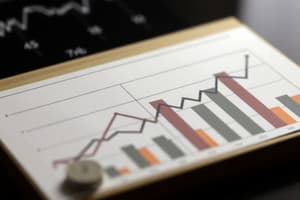Podcast
Questions and Answers
Which of the following statements accurately describes a cross-sectional dataset?
Which of the following statements accurately describes a cross-sectional dataset?
- It contains historical data without any specific time reference.
- It analyzes multiple individuals over multiple time intervals.
- It involves a single time interval for multiple individuals and variables. (correct)
- It involves one individual with multiple variables over time.
Time series datasets only analyze multiple variables for a single individual over several time intervals.
Time series datasets only analyze multiple variables for a single individual over several time intervals.
True (A)
What is the primary characteristic that distinguishes a sample from a population?
What is the primary characteristic that distinguishes a sample from a population?
A sample is a subset of individuals selected from a population.
In a dataset, the variable represents the feature we wish to study, such as ______ behavior.
In a dataset, the variable represents the feature we wish to study, such as ______ behavior.
Match the type of dataset with its description:
Match the type of dataset with its description:
What does 'n' represent in a sample size?
What does 'n' represent in a sample size?
Quantitative variables can take on values that are typically expressed as numbers.
Quantitative variables can take on values that are typically expressed as numbers.
What does the variable 'Value' in a dataset refer to?
What does the variable 'Value' in a dataset refer to?
What does the variable measured in 'Liters per 100 km' represent?
What does the variable measured in 'Liters per 100 km' represent?
In a histogram, the area of each rectangle represents the frequency of value classes.
In a histogram, the area of each rectangle represents the frequency of value classes.
What is the relationship between gallons and liters based on the conversion factor provided?
What is the relationship between gallons and liters based on the conversion factor provided?
A bimodal distribution has ______ major peaks?
A bimodal distribution has ______ major peaks?
Match the following types of data analysis with their descriptions:
Match the following types of data analysis with their descriptions:
Which of the following best describes continuous variables?
Which of the following best describes continuous variables?
What is one advantage of using histograms to analyze data?
What is one advantage of using histograms to analyze data?
A unimodal distribution has more than one prominent peak.
A unimodal distribution has more than one prominent peak.
What distinguishes panel data from cross-sectional data?
What distinguishes panel data from cross-sectional data?
Continuous quantitative variables can take any value within a given interval of real numbers.
Continuous quantitative variables can take any value within a given interval of real numbers.
What are qualitative variables and give an example?
What are qualitative variables and give an example?
The _____ of OECD countries would be an example of panel data.
The _____ of OECD countries would be an example of panel data.
Match the type of variable with its description:
Match the type of variable with its description:
Which of the following is an example of a discrete quantitative variable?
Which of the following is an example of a discrete quantitative variable?
Time series data consists of multiple individuals observed at the same time intervals.
Time series data consists of multiple individuals observed at the same time intervals.
What is the primary focus of cross-sectional analysis?
What is the primary focus of cross-sectional analysis?
Flashcards
Population
Population
A complete set of individuals with a shared characteristic.
Sample
Sample
A subset of a population.
Observation
Observation
An individual element within a population or sample.
Sample Size (n)
Sample Size (n)
Signup and view all the flashcards
Population Size (N)
Population Size (N)
Signup and view all the flashcards
Variable
Variable
Signup and view all the flashcards
Value
Value
Signup and view all the flashcards
Cross-Sectional Data
Cross-Sectional Data
Signup and view all the flashcards
Time Series Data
Time Series Data
Signup and view all the flashcards
Consommation [L/100 km]
Consommation [L/100 km]
Signup and view all the flashcards
Histogram
Histogram
Signup and view all the flashcards
Unimodal Distribution
Unimodal Distribution
Signup and view all the flashcards
Bimodal Distribution
Bimodal Distribution
Signup and view all the flashcards
Value Classes (Histogram)
Value Classes (Histogram)
Signup and view all the flashcards
Continuous Variable
Continuous Variable
Signup and view all the flashcards
Discrete Variable
Discrete Variable
Signup and view all the flashcards
Panel Data
Panel Data
Signup and view all the flashcards
Cross-Sectional Data
Cross-Sectional Data
Signup and view all the flashcards
Time Series Data
Time Series Data
Signup and view all the flashcards
Quantitative Variable
Quantitative Variable
Signup and view all the flashcards
Qualitative Variable
Qualitative Variable
Signup and view all the flashcards
Continuous Variable
Continuous Variable
Signup and view all the flashcards
Discrete Variable
Discrete Variable
Signup and view all the flashcards
mpg (variable)
mpg (variable)
Signup and view all the flashcards
cyl (variable)
cyl (variable)
Signup and view all the flashcards
am (variable)
am (variable)
Signup and view all the flashcards
Study Notes
Data Analysis
- Data analysis is a field of study that focuses on extracting meaning from data
- Key concepts include population, sample, observation, size/variables, and values.
- A population consists of all individuals with a common characteristic. For example, voters, students, or regions.
- A sample is a subset of the population randomly selected. This sample represents the population's attributes.
Some Definitions
- Population: A set of individuals possessing a common characteristic (e.g., all French voters, all European regions.)
- Sample: A randomly selected subset of the population. (e.g., randomly selected voters, randomly selected students from all students)
- Observation: An element in the population or the sample (e.g., an individual voter, a specific region).
- Size: The number of individuals in the sample (n) or population (N).
- Variable: A particular feature or characteristic being studied (e.g., voting behavior, grades, accident death rates).
- Value: Represents specific categories or measured values that a variable can take on. (e.g., Republican or Democrat for a Vote, 0, 1, 2, 3,…, 20 for a Grade)
Types of Datasets
- Cross-section: Observations collected at a single point in time. (e.g., data from many individuals at a single point in time)
- Time series: Observations of a variable over time. (e.g., GDP data over several years from one country)
- Panel data: Observations of multiple individuals over time. (e.g., collecting data about GDP over time for multiple countries or many individuals/regions)
Types of Variables
- Quantitative: Variables expressed numerically with a specific order (e.g., age, GDP). These can be further subdivided into:
- Continuous: Can take on any value within a given interval (e.g., height, temperature).
- Discrete: Can only take on a limited set of values, often integers (e.g., number of children, number of TVs).
- Qualitative: Variables that identify groups or categories (e.g., political preferences, gender, opinions). These qualitative variables can be further categorized as binary variables (e.g., smoker/non-smoker, manual/automatic transmission) or non-binary variables (e.g., different types of car brands like database chickwts ).
DataFrames
- Data frames are organized data tables.
- They often store a variety of information about an observation
- Example, data on car features including consumption, model, design aspects, performance, and other details
Car Consumption
- Analyzing the average fuel consumption of cars in a sample.
- Whether the consumption of fuel varies from car to car in a homogenous way.
- Creating a variable that measures consumption in liters per 100 km.
Histograms
- A histogram is a graphical representation that illustrates the distribution of a variable's values. It displays the frequencies of values within defined groups.
- The highest bars in a histogram represent the values that frequently appear in the data set.
- This helps to quickly grasp the frequencies that appear within predefined intervals or classes of values
Distribution Shapes
- Unimodal: A distribution with one prominent peak.
- Bimodal: A distribution with two major peaks.
- Multimodal: A distribution with more than two major peaks.
- Uniform: A distribution where peaks occur with similar probability
Skewness
- Histograms with long tails toward the right are called "right-skewed"; long tails toward the left are left-skewed
- Symmetrical histograms show an equal distribution of data points around the mean
Exercises and Examples
- Examples of real-world data analysis using earthquakes magnitude data, depth distributions
- Exercises to highlight how to analyze variables, determine whether variables are distributed uniformly, understand sample distributions, find the median or average values, and/or use percentiles to select groups.
- How to use boxplots to illustrate the distribution's characteristics including the median, upper, and lower bound ranges.
Studying That Suits You
Use AI to generate personalized quizzes and flashcards to suit your learning preferences.




